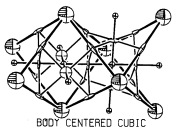
The canonical critical point network within a crystal forms a unique directed graph connecting pits (polyhedra) to pales (faces) to passes (edges) to peaks (atoms) by the gentlest up-density path, and may be represented by ORTEP `critical polyhedra drawings' (see figure) with spheres, prolate ellipsoids, oblate ellipsoids and smaller spheres for peaks, passes, pales, and pits, (i.e., 0,1,2,3) respectively, connected along canonical paths. Alternately, critical point networks embedded into orbifolds (defined below) provide a more concise depiction of crystal structure topology. Example illustrations of NaCl and FCC structures in Fm3m, and HCP and hexagonal diamond in P63/mmc, and BCC in Im3m will be compared. The (0,1,2,3)'s are on Wyckoff sites (a+b,e,d,c), (a,d,f,c+b), (c,g+h,b+d+k,a+f), (f,c+g,a+h,b+d), and (a,c,d,b), respectively. These critical point sets may differ from quantum chemistry results which may have additional peaks not on atomic centers.
Each space group produces a unique orbifold by folding up the space group's geometrical representation to overlay all symmetry-equivalent points. The mirrors, rotation axes, and symmetry points become the singular set of the orbifold. Mirrors become a silvered boundary on the orbifold and rotation axes become knots, links, or graphs with point symmetry elements at the vertices. There is a 1:1 correlation between Wyckoff sites and singular set components except that a 3-fold axis or its intersecting elements may be continued through the intersection. The cubic Fm3m yields a tetrahedral orbifold bounded by mirrors. The asymmetric unit polyhedra for P63/mmc and Im3m have mirrors on all but one face, where each has a 2-fold axis bisecting a glide face. Folding around these 2-folds produces closed silvered boundaries. Orbifolds may become an everyday working concept for 21st century crystallographers.
Research sponsored by the Laboratory Directed R&D Program of ORNL, managed for the U.S. DOE by Martin Marietta Energy Sys., Inc., under cont. DE-AC05-84-OR21400.